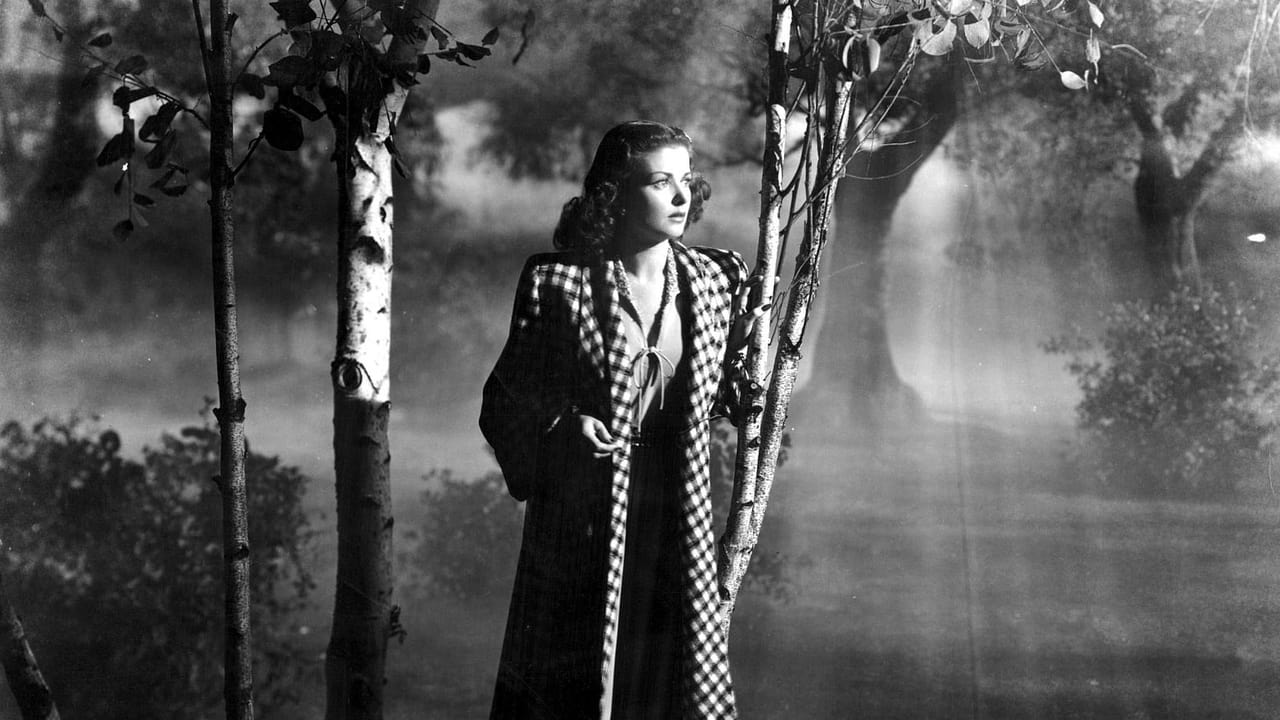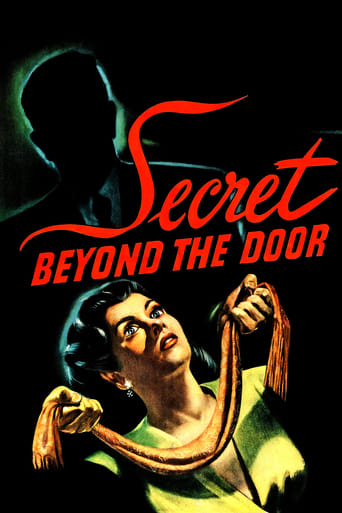

Highly derivative this low-budget film noir thriller may be but with Fritz Lang at the helm, you forget the ridiculous plot and admire instead the cinematography and atmosphere he brings to proceedings. And when I say ridiculous, I mean it, how else to describe a storyline where a widowed architect marries a wealthy city girl and takes her to his big old house in the country where he's made over a number of the rooms into murder tableaux. You might think she'd look for the door marked "Exit", but no Joan Bennett herself gets obsessed with the one room he's locked up, the mysterious number 7 and before too long is making a copy of the key, so she can investigate, naturally at the dead of night.Being the 40's the Freudian overtones are overpowering, as the husband, Michael Redgrave in his first Hollywood role, seems to be over-reacting to years of unhealthy female influence and dominance in his life as his mood swings like, well, I guess you'd say, a door.In the background there's an apparently disfigured housekeeper Miss Robey, Redgrave's supportive sister and his difficult, moody son but the main tension is between the leads as it builds gradually to a fiery ending.The plot may creak at times like an old floorboard, Redgrave and Bennett are somewhat stiff and cold in their parts and the continuity isn't all it could be, but if like me you like film noir settings then this is for you too. Thus we get Bennett's interior monologues, lots of shots of her in front of mirrors, lots of scenes with darkened doors and symbolic keys, and even a shroud-like mist followed by a thunderstorm on the climactic night. There are some great shots of starkly-lit corridors and a wonderfully imaginative dream sequence (yes, it has those too) of Redgrave's where he's prosecuting himself in front of a judge and jury whose faces are in shadow. Dmitri Tiompkin's atmospheric score adds a lot to the overall mystery and dread, particularly at the end.This may not be Lang's best American film but there was more than enough in it to keep an avowed fan like me keenly watching.
... View MoreThis thing is somewhat like Rebecca, in a way. There is an impulsive marriage of a young woman, Celia (Joan Bennett) to a mysterious man, Mark (Michael Redgrave). After the marriage Celia finds out he has been married before, except this time, there is a son by that marriage. And her husband has a personal assistant who is facially deformed and is prone to setting fires. However, Celia is not like Rebecca. She is full of life and not unsure of herself at all.One night, shortly after their marriage, Mark, an architect, talks about how he "collects" rooms as a hobby at a party at their house. Before the guests go look at the rooms, Celia tells the guests how her husband has said in the past that happy occasions are often tied to the rooms in which they occur. However, this tour is not one of happy events, instead all of the rooms are replicas of rooms in which grisly murders have occurred, and the new husband has the murders and the rooms down to the last detail. The look on Celia's face shows that she is suddenly wondering what exactly is going on in the head of that husband of hers.And then one more secret..there is a door where Mark is working away on another replica room where Bennett is not allowed to go. Then one day she manages to get in and finds....I'll let you watch and find out. Let me just say if not for the great visual style of Lang, the fact that Michael Redgrave had a knack for being creepy when he wants to and Joan Bennett could aptly project just about any emotion, and don't forget the score, this thing would have been a total washout, because the ideas are not that original and the ending is just not all that it was built up to be, given all of the wind machines, at least not for me.
... View MorePseudo-Hitch intriguing drama about a woman who gradually realizes she is married to a killer and may be next on his list .This classic suspense film contains emotion , intrigue , chills, and evocative scenarios . When a lovely as well as wealthy heiress named Celia (Joan Bennett) spends a fun holiday she meets a good-looking guy called Mark Lamphere and ends up falling in love with him . Later on , she marries the widower (Michael Redgrave's first American film) and finds out weird happenings about him . She and her new husband, settle in an ancient mansion on the East coast, she discovers he may want to kill her . Understandably , she wonders what plans he might have for her . The mansion has got a lot of rooms that are replicas of known murder sites . In the tour of the three rooms, Mark Lamphere recounts the tales of three murders, all of which are fictional. However in the first room, he mentions the St Bartholomew's Day massacre and the Guise family in France. The massacre is a real historical event, where French Roman Catholics attacked French Huguenots (Protestants) on 24th of August 1572 resulting in many deaths.Dazzling Hitch/style suspense movie about a beautiful woman marries a rare man with a shock revelation around every corner their mansion . It packs hallucination , treason , Bennett plays a rich wife trying to help her hubby , well played by Michael Redgrave , who is suffering from amnesia and who might be a murderer too . The picture takes elements from classic Hitchcock films , carrying out a crossover among ¨Suspicion ¨, ¨Spellbound¨ and ¨Rebeca¨ . In fact ,Fritz Lang's attempt to do his version of Rebeca (1940) was a project fraught with disaster. It ran over budget and over schedule, while Lang was at constant loggerheads with his leading lady, Joan Bennett . As it stars the great Joan Bennett , being compellingly directed by Lang ; but it is not as outstanding as their former movies together : ¨Man hunt¨, ¨The woman in the window¨ and ¨Scarlet street¨. Support cast is pretty good such as Anne Revere as Caroline Lamphere , Barbara O'Neil as Miss Robey and Paul Cavanagh as Rick Barrett . Atmospheric as well as mistly cinematography in black and white by Stanley Cortez . Thrilling and frightening musical score by the classic Miklos Rozsa . The motion picture was professionally directed by Fritz Lang . Lang directed masterfully all kind of genres as Noir cinema as ¨Big heat , Scarlet Street and Beyond a reasonable doubt¨ , Epic as ¨Nibelungs¨, suspense as ¨Secret beyond the door, Clash by night¨ , Western as ¨Rancho Notorious and Return of Frank James ¨ and of course Adventure as ¨Moonfleet¨ .
... View MoreWith Fritz Lang. Michael Redgrave, Joan Bennett and the supporting cast this movie starts off great. Miss Bennett is so gorgeous, the leading ladies of today must be so jealous while the casting directors must wonder where did all the beauty go, Redgrave is as good as ever I have seen. I know the script can get a bit long toothed but that's just because current films don't rely on story driven movies. Natalie Schafer is such a scene steal-er. I loved this movie. Could not recommend it enough if you have a cold March evening and there is nothing ON TV, just go and bring yourself back to the mid 40's, the fashions, the set dressing will do it and enjoy the masters at movie making doing what they do best.. LOVED IT...
... View More